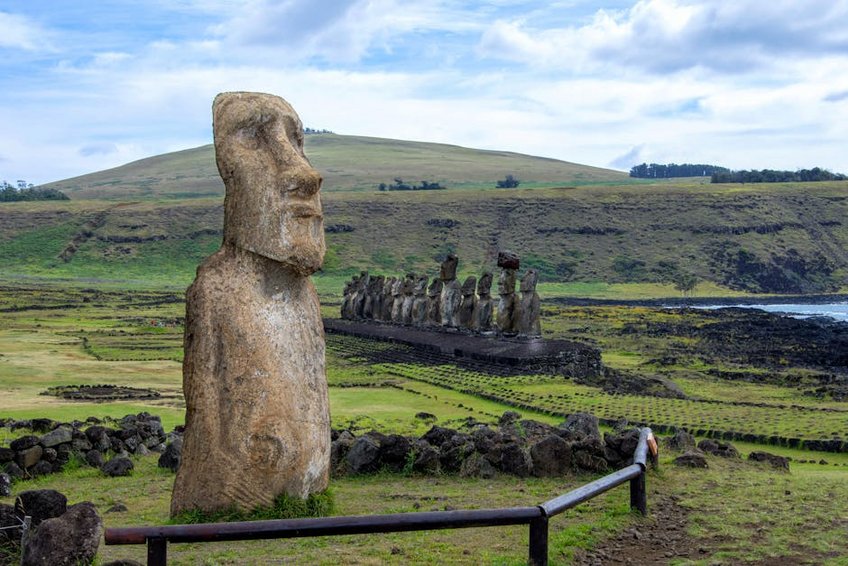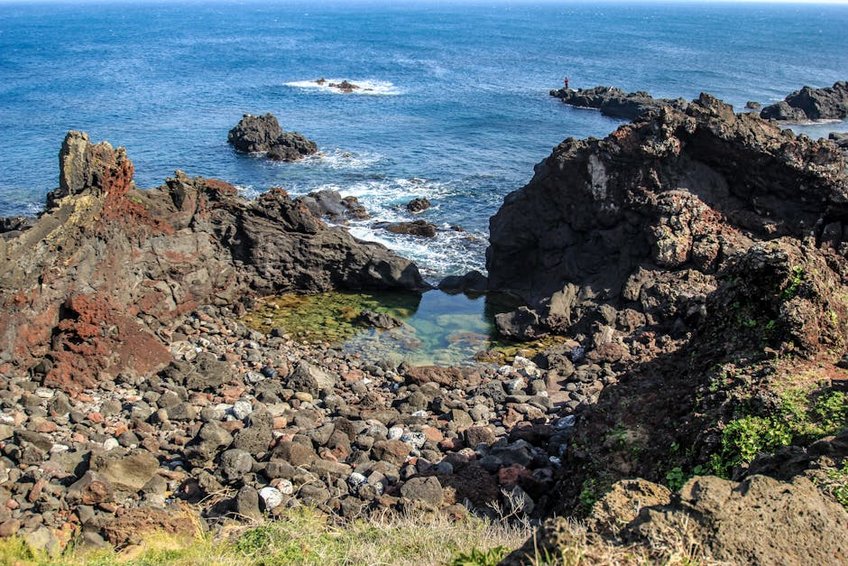Jeju Island Volcanic Rock: A Geological Marvel You Must Experience
Exploring Jeju Island volcanic rock formations offers one of the most unique geological adventures you’ll find anywhere in Asia. This South Korean island, formed entirely through volcanic activity millions of years ago, presents a dramatic landscape where black volcanic rock contrasts beautifully with turquoise waters and lush greenery. As you walk along the coastline or hike through the island’s interior, you’ll encounter fascinating formations that tell the story of Jeju’s fiery birth and gradual erosion by wind and sea. The Jeju Island volcanic rock experience isn’t just about geology—it’s about connecting with nature’s raw power and appreciating how volcanic activity created an island that’s now a UNESCO World Natural Heritage site. Whether you’re a geology enthusiast, nature lover, or simply seeking unique travel experiences, the volcanic landscapes here will leave you in awe of our planet’s incredible natural processes.
Jeju Island Volcanic Rock Essential Information
Understanding the geological background of Jeju Island volcanic rock formations will significantly enhance your appreciation of this remarkable destination. The island emerged from the sea approximately 2 million years ago through volcanic eruptions that continued until relatively recently in geological terms—about 1,000 years ago. Hallasan Mountain, standing at 1,950 meters (6,398 feet), is the island’s central volcano and the highest peak in South Korea. The volcanic activity created various rock types including basalt, trachyte, and volcanic ash, which weather into the distinctive formations you’ll see throughout the island. The porous nature of Jeju Island volcanic rock allows for unique ecosystems to develop and has influenced local architecture, with traditional walls and buildings constructed using these dark stones. The volcanic soil also contributes to Jeju’s agricultural success, particularly for citrus fruits and other crops that thrive in the mineral-rich earth.
Geological Formation Process – What You Need to Know
- Jeju Island formed through shield volcano activity with low-viscosity lava that created broad, gently sloping formations rather than steep volcanic cones
- The volcanic rock primarily consists of basalt with high iron and magnesium content, giving it the characteristic dark color that contrasts with the blue ocean waters
- Unique columnar jointing patterns formed as lava cooled and contracted, creating geometric formations that are particularly visible at Jusangjeolli Cliff
- Budget travelers can experience Jeju’s volcanic wonders for approximately $50-70 USD per day by staying in hostels or guesthouses, using public transportation, and enjoying local street food and market meals
- Mid-range travelers should budget $100-150 USD daily for comfortable hotels, rental car or taxi services between major sites, and meals at traditional restaurants serving Jeju’s famous black pork and seafood
- Luxury experiences including resort accommodations, private guides, and fine dining will cost $250-400+ USD per day, with premium options for helicopter tours over volcanic landscapes
- Jeju Special Self-Governing Province Official Website
- UNESCO World Heritage Centre – Jeju Volcanic Island and Lava Tubes
Conservation Status and Protection
Jeju’s volcanic rock formations enjoy multiple layers of protection that recognize their global significance. The island was designated a UNESCO World Natural Heritage site in 2007 specifically for its volcanic landforms and lava tube systems. Additionally, it’s recognized as a UNESCO Global Geopark, ensuring that both conservation and educational aspects are maintained. When visiting these sensitive geological sites, you’ll need to stay on marked paths and avoid touching or removing any rocks. The preservation efforts extend to the entire island ecosystem, including the unique cultural heritage that developed in harmony with the volcanic landscape. Your visit contributes to conservation when you follow guidelines and support local eco-tourism initiatives.
Jeju Island Volcanic Rock Planning Your Trip
Planning your Jeju Island volcanic rock adventure requires consideration of seasonal variations, transportation options, and activity preferences. The island experiences four distinct seasons, each offering different advantages for exploring the volcanic landscapes. Spring (April-June) brings comfortable temperatures and blooming flowers, while summer (July-August) offers warm weather perfect for coastal exploration but with higher rainfall. Autumn (September-November) provides crisp air and stunning foliage contrasts against the black rocks, and winter (December-March) offers dramatic seascapes with fewer crowds. You’ll want to allocate at least 4-5 days to properly experience the major volcanic rock sites without rushing. Transportation planning is crucial—while public buses serve most attractions, renting a car provides flexibility to visit more remote volcanic formations at your own pace.
Best Time to Visit Jeju Volcanic Formations
The optimal time for exploring Jeju Island volcanic rock formations depends on your weather preferences and tolerance for crowds. April through June and September through November typically offer the most pleasant conditions with mild temperatures (15-25°C/59-77°F) and lower rainfall. These shoulder seasons provide excellent photography conditions with good lighting and manageable visitor numbers. July and August bring warmer temperatures (25-30°C/77-86°F) but also the highest rainfall and tourist crowds, particularly from domestic Korean travelers. Winter months offer a completely different experience with dramatic waves crashing against volcanic coastlines and occasional snow on Hallasan Mountain, though some facilities may have reduced hours. Regardless of season, always check weather forecasts as Jeju’s coastal location makes weather patterns unpredictable.
Budget Planning and Costs
Essential Preparation Checklist
Preparing properly for your Jeju Island volcanic rock exploration will ensure a more enjoyable and safe experience. Footwear is paramount—sturdy walking shoes with good grip are essential for navigating uneven volcanic terrain and coastal paths. Pack layers regardless of season, as weather can change quickly, especially at higher elevations like Seongsan Ilchulbong Peak. Bring rain protection even during drier months, as coastal areas experience unpredictable showers. Don’t forget sun protection—the black volcanic rock absorbs and radiates heat, making sun exposure more intense. If you plan to explore lava tubes, bring a light jacket as temperatures remain cool (10-15°C/50-59°F) year-round. Finally, ensure your phone has offline maps downloaded and a translation app, as English signage may be limited at some geological sites.

Jeju Island Volcanic Rock Top Attractions and Activities
Jeju Island offers an incredible variety of volcanic rock attractions that showcase different aspects of the island’s geological history. From dramatic coastal cliffs to ancient lava tubes, each site provides a unique perspective on how volcanic activity shaped this island paradise. The must-see locations include Seongsan Ilchulbong (Sunrise Peak), a volcanic tuff cone that rises dramatically from the sea and offers breathtaking sunrise views. Jusangjeolli Cliff features spectacular hexagonal columnar jointing that demonstrates the geometric patterns formed as lava cooled. The Manjanggul Lava Tube, one of the longest in the world, allows you to walk through an underground tunnel created by flowing lava. Yongmeori Coast showcases wave-eroded volcanic cliffs that resemble a dragon’s head, while Sanbangsan Mountain presents a dramatic volcanic dome with a temple built into its side. Each location tells a different chapter of Jeju’s volcanic story.
Must-See Volcanic Highlights
No visit to Jeju would be complete without experiencing these iconic volcanic rock formations. Seongsan Ilchulbong, formed by hydrovolcanic eruptions approximately 5,000 years ago, features a crater that’s 600 meters in diameter and 90 meters deep—you can hike to the rim for panoramic ocean views, especially spectacular at sunrise. The Manjanggul Lava Tube stretches for 7.4 kilometers (4.6 miles), with 1 kilometer open to visitors, showcasing incredible formations like lava stalactites, stalagmites, and flow lines that indicate the direction of ancient lava flows. At Jusangjeolli Cliff, you’ll witness nature’s architectural masterpiece—hexagonal rock columns that formed as thick lava flows cooled and contracted, creating geometric patterns that appear almost man-made. Each site offers unique perspectives on volcanic processes and excellent photography opportunities.
Hidden Gems and Local Favorites
Beyond the famous sites, Jeju hides lesser-known volcanic treasures that offer more intimate experiences. Soesokkak Estuary, where a freshwater stream meets the ocean through volcanic rock formations, provides a serene setting for traditional raft rides. Gimnyeong Maze Park, constructed entirely from Jeju volcanic rock walls, offers fun navigation challenges with educational elements about local geology. Woljeongri Beach features volcanic sand and rock formations perfect for sunset photography without the crowds of more famous beaches. For truly adventurous experiences, consider visiting during low tide to explore tidal pools formed in volcanic rock basins, where you might spot marine life adapted to these unique environments. Local guides often know secluded volcanic formations away from main tourist routes—consider hiring one for half-day explorations.
Jeju Island Volcanic Rock Practical Travel Information
Navigating Jeju Island to experience its volcanic rock formations requires understanding transportation options, accommodation choices, and entry requirements for various sites. The island measures 73 kilometers (45 miles) east-west and 31 kilometers (19 miles) north-south, with most volcanic attractions located along the coastline or within easy access from the circular coastal road. Jeju International Airport (CJU) serves as the main entry point, with frequent flights from Seoul and other major Asian cities. Once on the island, you’ll find an efficient public bus system that connects major towns and attractions, though service to more remote volcanic sites may be limited. Renting a car provides the most flexibility for volcanic rock exploration, allowing you to visit sites at optimal times for photography and avoid tour group crowds. Accommodation ranges from luxury resorts to traditional hanok guesthouses, with clustering around major volcanic attractions.
| Transportation Method | Key Features | Daily Cost (USD) |
|---|---|---|
| Rental Car | Maximum flexibility, access to remote sites, English GPS available | $40-80 |
| Public Bus | Economical, extensive network, but slower with limited schedules | $5-10 |
| Taxi Services | Convenient for point-to-point travel, available throughout island | $30-60 |
| Tour Buses | Guided commentary, structured itineraries, limited flexibility | $50-100 |


